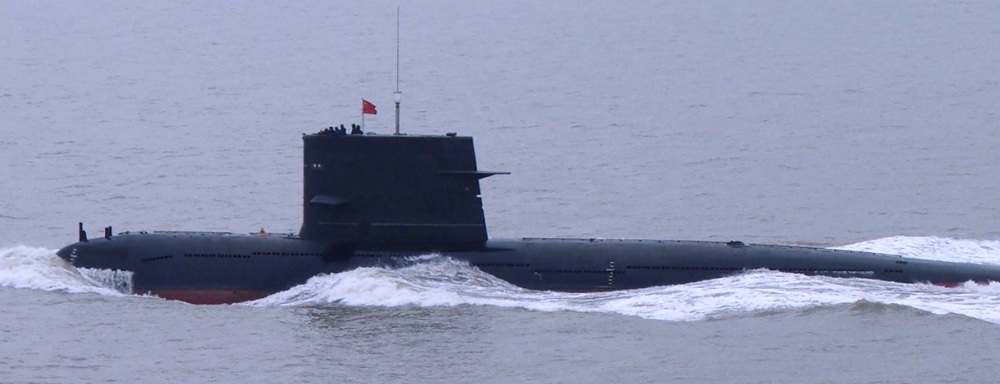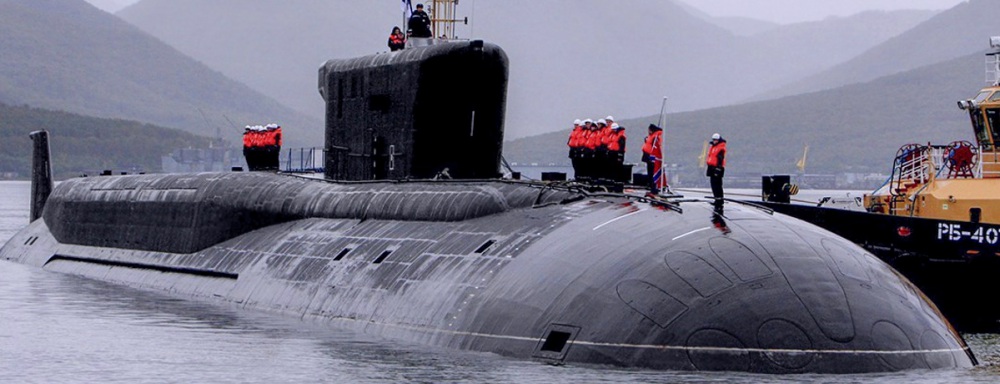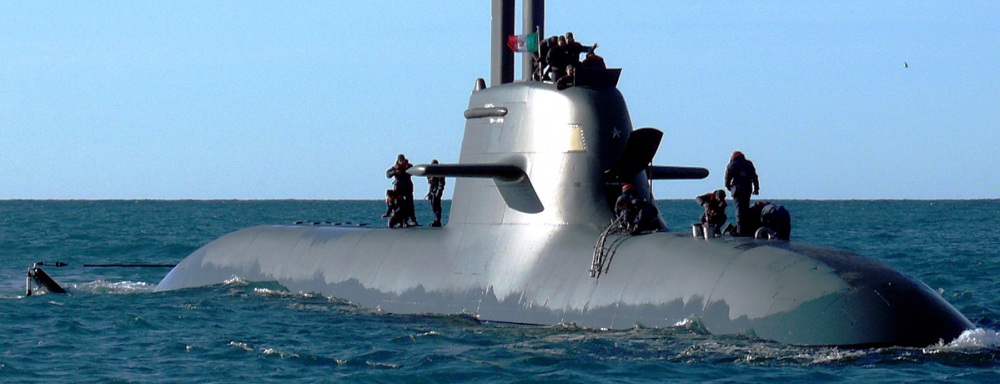
About the image
Capabilities at a Glance
The People’s Liberation Army Navy (PLAN) of China possesses both a nuclear-powered submarine fleet and a robust diesel-electric submarine fleet. While the PLAN is currently developing its nuclear-powered submarine capabilities, its diesel-electric submarine fleet remains the backbone of China’s submarine forces. While its growth is declining, United States government reports indicate the fleet could grow to between 65 and 70 submarines by 2020s. With two submarines in process of having hulls fitted out.1
Total Submarines in Fleet: 56
- Ballistic Missile Submarines (SSBNs): 6
- Nuclear-powered attack submarines (SSNs): 6
- Diesel-electric attack submarines (SSKs): 44
- Air-independent propulsion (AIP) enabled: 17/44
Xia Class SSBN
History
China is known to have built over 80 Romeo (Type 33) attack submarines from 1962 to 1984, as well as at least an additional 20 Ming-class (Type 35) submarines, which were based on the Soviet Romeo design.2 The first SSBN to be designed and built in Asia was a Chinese Xia-class (Type 092). It was commissioned in 1983 and entered into service in 1987. The Xia-class was slow and noisy, however, and was quickly replaced by the Jin-class (Type 094) submarines.3 The Shang-class submarines (Type 093) closely resemble the Russian Victor-III submarine, suggesting that the Russian Rubin Design Bureau provided technical assistance for the construction of these submarines.4 The Yuan-class is the PLAN’s first class of diesel-electric submarines to be equipped with an indigenously developed air-independent propulsion system (AIP).5 The development of China’s nuclear-powered submarines was also addressed domestically.6
Modernization and Current Capabilities
In December 2012, China and Russia signed a framework agreement for joint construction of four Lada-class (Project 677E) diesel-electric attack submarines (the Russian export version is known as Amur-1650).7 The first Amur-1650 submarine was reportedly delivered on October 18, 2014.8 However, neither Chinese nor U.S. official reports list the Amur-1650 in current inventories, and there has been no update on the project since 2014.
In April 2015, the PLAN commissioned three upgraded Shang-class (Type 093B) nuclear-powered attack submarines. The advanced Shang-class offers improvements in speed and noise as well as a new vertical launch system.9 The vessels are fitted with YJ-18 anti-ship ballistic missiles that have a range of 400 kilometers. The U.S. Department of Defense estimates that by the mid-2020s China will likely construct the Type 093B guided-missile nuclear attack submarine (SSGN), a new variant of the Shang-class that would improve anti-surface warfare capability and clandestine land-attack ability. The Department of Defense also estimates that China will begin construction of the Type 096 SSBNs armed with the follow-on JL-3 SLBM in the early 2020s.10
Ship Biographies
Jin-Class (Type 094)
China possesses six operational Jin-class ballistic missile submarines (SSBNs). These submarines are 135 meters long with a 12.5-meter-wide beam and can travel over 20 knots when submerged. Their weapons systems can carry 12 JL-2 SLBMs.11
Shang-Class (Type 093)
China possesses six Shang-class nuclear powered attack submarines (SSNs). These submarines are 110 meters long with a 11-meter-wide beam and can travel up to 30 knots when submerged. Their weapons systems include torpedoes and cruise missiles.
Yuan-Class (Type 039A or Type 041)
China possesses seventeen Yuan-class diesel electric attack submarines (SSKs). These submarines are 77.6 meters long with an 8.4-meter-wide beam and can travel up to 20 knots when submerged.12 Their weapons systems include torpedoes and anti-ship missiles.
Kilo-Class
China has purchased twelve Russian-origin Kilo-class submarines: two Project 877 vessels, two Project 636 vessels, and eight Project 636M vessels. The Project 877 vessels are 72.9 meters long with a 9.9-meter-wide-beam and can travel 20 knots when submerged.13 The Project 636 vessels are 72.6 meters long and can travel up to 17 knots when submerged.14 In late 2021, the PLAN retired the two Project 877 vessels, and China currently possesses ten Russian-origin Kilo-class submarines.15
Song-Class (Type 039)
China possesses thirteen Song-class diesel electric attack submarines (SSKs). These submarines are 74.9 meters long with an 8.4-meter-wide beam and can travel up to 22 knots when submerged. Their weapons systems include torpedoes and anti-ship missiles.
Ming-Class (Type 035)
China possesses Ming-class diesel electric attack submarines (SSKs).16 These submarines are 76 meters long with a 7.6-meter-wide beam and can travel up to 18 knots when submerged. Many variants of Type 035 class submarines have been developed such as Type 035G and the Type 035B. All Ming-class submarines possess 533mm torpedo tubes and Type 035B are capable of firing cruise missiles from its torpedo tubes.
Import and Export Behavior
Imports
China’s first submarine acquisition occurred on 4 June 1953 when the Soviet Union supplied them with 32 fully operational warships, as well as the license to build the Soviet O3-class (NATO: Whiskey) submarine.17 Since the mid-1990s, the PLAN has purchased 12 Russian-built Kilo-class submarines, eight of which are capable of launching ASCMs.18 China is also expected to have received a Russian Amur-class submarine.19
Exports
China has recently entered the submarine export market. State-owned China Shipbuilding Industry Corporation (CSIC) sold indigenous designs to Thailand and Pakistan.20
In June 2015 the Thai government purchased three export variant of the Yuan-class (Type 039B or Type 041) diesel-electric submarines from Beijing at $383 million each. This trade includes weapons systems, spare parts, and technology transfers.21 In 2017, Thailand purchased another YUAN variant submarine. The first submarine is expected to be delivered in the early 2020s.22 As of late 2021, it was not delivered due to contractual delays.23
In 2016 the Pakistani government approved the purchase of eight submarines fitted with AIP systems from China based on the Yuan-class (Type 039) for more than $3 billion.24 The Chinese Shipbuilding Industry Corporation will build the first four submarines, with the remaining four constructed in Pakistan at Karachi Shipbuilding and Engineering Works.25
In 2016, China delivered two MING-class submarines to Bangladesh. In 2017 and 2018 China sold two Type 053H3 frigates to Bangladesh and four Type 054A frigates to Pakistan.26 In 2021, China delivered one Ming-class submarine to Myanmar.27
Explore the Collection
Australia Submarine Capabilities
Brazil Submarine Capabilities
Chile Submarine Capabilities
Your are currently on
China Submarine Capabilities
France Submarine Capabilities
Germany Submarine Capabilities
Greece Submarine Capabilities
India Submarine Capabilities
Indonesia Submarine Capabilities
Iran Submarine Capabilities
Israel Submarine Capabilities
Italy Submarine Capabilities
Japan Submarine Capabilities
Malaysia Submarine Capabilities
Netherlands Submarine Capabilities
North Korea Submarine Capabilities
Pakistan Submarine Capabilities
Russia Submarine Capabilities
Singapore Submarine Capabilities
South Korea Submarine Capabilities
Sweden Submarine Capabilities
Taiwan Submarine Capabilities
United States Submarine Capabilities
Submarine Detection and Monitoring: Open-Source Tools and Technologies
Stay Informed
Sign up for our newsletter to get the latest on nuclear and biological threats.
More on

Russia Submarine Capabilities
Overview of Russia's submarine capabilities and import-export behavior.
United States Submarine Capabilities
Overview of the United States' submarine capabilities and import-export behavior.

Italy Submarine Capabilities
Overview of Italy's submarine capabilities and import-export behavior.
Glossary
- SSBN
- Ship, Submersible, Ballistic, Nuclear: A hull classification for a submarine capable of launching a ballistic missile. The "N", or nuclear, refers to the ship's propulsion system. SSBN's are generally reserved for strategic vessels, as most submarine launched ballistic missiles carry nuclear payloads. A non-strategic vessel carries the designation SSN, or attack submarine.
- Diesel-electric submarine
- Diesel-electric submarine: A submarine with a diesel-electric transmission. Diesel-electric transmissions require access to oxygen for the diesel generator to charge the submarine’s batteries or drive the motor. This type of submarine is thus louder and must surface more frequently than a nuclear-powered submarine. A diesel-electric submarine can fire conventional cruise missiles against land targets, and in theory, can also carry nuclear-tipped cruise missiles. Diesel-electric submarines are significantly cheaper to build and purchase than nuclear-powered vessels, which makes them the vessel of choice for smaller navies.
- Air Independent Propulsion Technology (AIP)
- Air Independent Propulsion Technology (AIP): A propulsion system that uses liquid (or compressed) oxygen or hydrogen fuel cells, thereby allowing submarines to stay submerged for longer periods without the need for external sources of oxygen. This increased endurance also increases a submarine’s survivability.
- Ballistic missile
- A delivery vehicle powered by a liquid or solid fueled rocket that primarily travels in a ballistic (free-fall) trajectory. The flight of a ballistic missile includes three phases: 1) boost phase, where the rocket generates thrust to launch the missile into flight; 2) midcourse phase, where the missile coasts in an arc under the influence of gravity; and 3) terminal phase, in which the missile descends towards its target. Ballistic missiles can be characterized by three key parameters - range, payload, and Circular Error Probable (CEP), or targeting precision. Ballistic missiles are primarily intended for use against ground targets.
- Cruise missile
- An unmanned self-propelled guided vehicle that sustains flight through aerodynamic lift for most of its flight path. There are subsonic and supersonic cruise missiles currently deployed in conventional and nuclear arsenals, while conventional hypersonic cruise missiles are currently in development. These can be launched from the air, submarines, or the ground. Although they carry smaller payloads, travel at slower speeds, and cover lesser ranges than ballistic missiles, cruise missiles can be programmed to travel along customized flight paths and to evade missile defense systems.
Sources
- U.S. Department of Defense, “Military and Security Developments Involving the People’s Republic of China 2022,” 29 November 2022, p. 52.
- U.S. Department of Defense, “Military and Security Developments Involving the People’s Republic of China 2015,” 7 April 2015, p. 9.
- “Xia Class Ballistic Missile Submarine,” Military-Today.com, accessed 8 July 2019.
- “Jane’s Sentinel Security Assessment - China,” IHS Jane’s, 17 February 2014, www.janes.com.
- Dave Majumdar, “China’s Advanced Submarines Are ’Breaking Records,’” The National Interest, 26 July 2018, www.nationalinterest.org.
- U.S. Congress, House, House Select Intelligence Committee, China’s Global Naval Strategy and Expanding Force Structure: Pathway to Hegemony, Testimony by James Fannell, 17 May 2018; in Nexus Uni, https://advance.lexis.com.
- “Jane’s Sentinel Security Assessment - China,” IHS Jane’s, 17 February 2014, www.janes.com.
- “China gets Russia’s best submarine technology, as Russia seeks to avoid economic recession,” China Daily Mail, 21 October 2015, www.chinadailymail.com.
- “China gets Russia’s best submarine technology, as Russia seeks to avoid economic recession,” China Daily Mail, 21 October 2015, www.chinadailymail.com.
- U.S. Department of Defense, “Military and Security Developments Involving the People’s Republic of China 2019,” 2 May 2019, p. 36.
- Hans M. Kristensen, “Chinese JIN-SSBNs Getting Ready?” FAS Strategic Security Blog: from the Federation of American Scientists, http://blogs.fas.org.
- “World Navies - China,” IHS Jane’s, 17 February 2014, www.janes.com.
- “Project 877EKM/636 Kilo Class Diesel-Electric Submarine,” 25 December 2005, web.archive.org.
- “Kilo Class,” Global Security, 7 November 2011, www.globalsecurity.org.
- U.S. Department of Defense, “Military and Security Developments Involving the People’s Republic of China 2022,” 29 November 2022, p. 53.
- U.S. Department of Defense, “Military and Security Developments Involving the People’s Republic of China 2013,” Office of the Secretary of Defense, pp. 6-7.
- John Wilson Lewis and Xue Litai, “Designing” China’s Strategic Seapower: The Politics of Force Modernization in the Nuclear Age, (Stanford, CA: Stanford University Press, 1994), 48.
- U.S. Department of Defense, “Military and Security Developments Involving the People’s Republic of China 2019,” 2 May 2019, p. 36.
- “China gets Russia’s best submarine technology, as Russia seeks to avoid economic recession,” China Daily Mail, 21 October 2015, www.chinadailymail.com.
- Kevin Wong, “China targets export market with latest submarine designs,” Jane’s 360, 12 December 2017, www.janes.com.
- Prashanth Parameswaran, “How Did China Just Win Thailand’s New Submarine Bid?” The Diplomat, 26 June 2015, www.thediplomat.com; “Thailand may produce three submarines from China for $1bn,” Naval Technology, 29 June 2015, www.naval-technology.com.
- Prashanth Parameswaran, “When Are China’s Submarines Coming to Thailand?” The Diplomat, 20 January 2017, www.thediplomat.com.
- U.S. Department of Defense, “Military and Security Developments Involving the People’s Republic of China 2022,” 29 November 2022, p. 152.
- Kevin Wong, “China targets export market with latest submarine designs,” Jane’s 360, 12 December 2017, www.janes.com.
- Franz-Stefan Gady, “China to Supply Pakistan with 8 New Stealth Attack Submarines by 2028,” The Diplomat, 30 August 2016, www.thediplomat.com.
- U.S. Department of Defense, “Military and Security Developments Involving the People’s Republic of China 2019,” 2 May 2019, p. 27.
- Xavier Vavasseur, “Myanmar Commissions Type 35B Ming-Class Submarine From China,” Navalnews, 27 December, 2021, www.navalnews.com.
